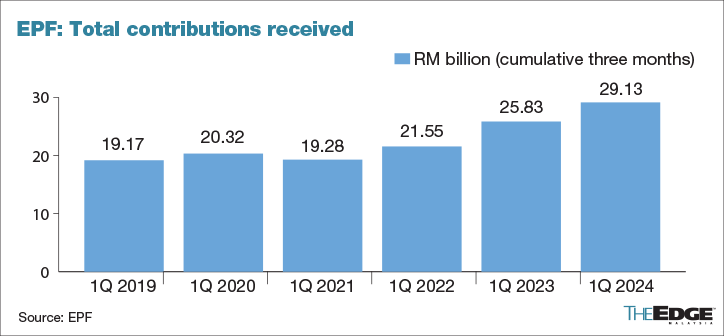
KUALA LUMPUR (June 12): The Employees Provident Fund (EPF) said its overall investment assets as at March 2024 grew to RM1.19 trillion, of which overseas investments account for 38% of the total assets.
The EPF’s overseas investments, which were mainly in equities, continued to outperform and add value to the EPF’s overall return as they generated RM9.88 billion in income, representing 51% of the total distributable income recorded.
In a statement on Wednesday, the EPF said total distributable income in the first quarter ended March 31, 2024 rose 33.1% year-on-year to RM19.20 billion, from RM14.42 billion a year earlier.
The fund said the distributable income does not include mark-to-market (MTM) gains of securities that have not been realised.
EPF chief executive officer Ahmad Zulqarnain Onn said the performance of global markets in the first quarter of 2024 was marked by resilient global growth, notably in advanced economies.
“The FBM KLCI index has increased by 10% year-to-date, reflecting increased confidence in the growth and impact of various new economic and industry policies.
“Internationally, the US economy continued to grow, lowering expectations for the US Federal Reserve rate cuts during the year, and major stock indices showcased strong rallies during the first quarter, led by a run-up in financial, healthcare and technology stocks,” he said.
“While first quarter results have been strong, financial markets remain subject to a number of risks that have been prevalent, namely ‘high for longer’ interest rates, geopolitical and conflict risks, and changes in policies resulting from a large number of elections being held in a number of large economies this year,” he said.
The EPF said that income from equities increased to RM13.15 billion during the quarter, from RM8.69 billion a year earlier.
The fund said the asset class remained the top income contributor at 68% of total distributable income.
It said the increase in income is attributed to the fund managers’ proactive strategy in realising capital gains during the market rally, taking advantage of the favourable conditions before the uncertain environment anticipated in the coming quarters.
Fixed income instruments continue to be the anchor for the EPF, providing a steady stream of income and mitigating the impact from short-term market volatility.
This asset class, predominantly Malaysian Government Securities (MGS), contributed 27% or RM5.14 billion to the total distributable income for 1Q2024.
Real estate and infrastructure registered an income of RM220 million in 1Q2024, while money market instruments generated RM690 million, in line with the return expectations set for these asset classes.
EPF raises expectations for global growth, flags key risks
Ahmad Zulqarnain said the EPF is keeping an optimistic outlook for the domestic economy, which he said started 2024 on a firm footing, recording an acceleration in growth to 4.2% in 1Q2024.
He said the country’s labour market remains healthy, with employment and the labour force participation rate continuing to rise.
He added that Malaysia is expected to continue recording solid growth in 2024, supported by continued strength in domestic demand and a recovery in exports.
“Bank Negara Malaysia forecasts that Malaysia’s economy will grow at a rate of between 4% and 5% this year and that inflation will stay moderate, averaging between 2% and 3.5%.
“The outlook for global growth this year has become more positive.
“However, risks remain high due to uncertainty surrounding the impact of monetary policy tightening on growth and financial market stability, China’s property market crisis, as well as geopolitical tensions that could push commodity prices higher and threaten global economic growth,” he said.
Meanwhile, Ahmad Zulqarnain said that increase in the number of Malaysians opting to save with the EPF, as well as current members making voluntary contributions, signify the country’s continued economic growth momentum, elevated by sound Malaysia Madani policies.
He added that the EPF will continue to enhance its capabilities to meet the evolving needs and expectations of members and employers, as well as build up its portfolio performance, guided by its long-term Strategic Asset Allocation (SAA).
- Loke assures thorough probe into Kluang fatal crash
- China's top airlines post fifth year of losses in 2024 in the face of domestic competition
- Zelenskiy cautious about new minerals deal but says past US aid not a loan
- Musk’s xAI start-up swallows up X social network in surprise deal
- Seeking opportunities in a risk-off market
- Trump, Carney talk about new deal, plan meeting after Canada’s election
- Trump open to tariff negotiations, will hit drug imports ‘soon’
- UEM Edgenta unit secures interim agreement to provide hospital support services
- Malaysia to deploy Nadma teams to aid Myanmar's earthquake relief operations
- Stocks lose ground amid inflation, trade war worries; gold at record high


